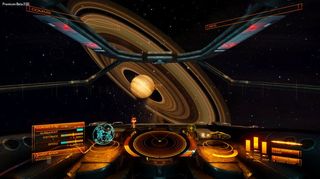Can you play Elite: Dangerous on an Android tablet? It turns out you can…

Okay, so this is mostly just going to be filed under the 'for shits and giggles' category, but Nvidia have just delivered their latest SHIELD Tablet to the office and I've been taking it out for a quick spin.
And what better way to test it's streaming capabilities than taking to the inky black in a shiny new Sidewinder...
Now there are a few Tegra K1 optimised games out there to play natively on the new Nvidia-powered Android tablet, like Portal, Trine 2 and Half-Life 2, and there are loads of games that are configured for streaming from your PC too.
But one of the neat things about Nvidia's SHIELD devices and their Gamestream technology is that, if you point the GeForce Experience software at an executable that isn't on the list of supported games, it will always have a go.

That was all I had to do and the SHIELD Tablet was happily streaming Elite: Dangerous. Getting the wireless controller running in-game was trickier.
Unfortunately there's a little finessing you need to do to get ED to recognise the SHIELD Controller - you need to have a controller plugged into the host machine for the game to realise that it's got one available.
From there it was good to go. All the standard joypad controls worked and, so long as I was relatively close to the router my test rig was plugged into, the streaming quality was great.
PC Gamer Newsletter
Sign up to get the best content of the week, and great gaming deals, as picked by the editors.
Further away and the resolution drops so that it can maintain both low latency for controls and the frame rate, but if you're in the same room as the router you'll be able to indulge in as much space-based piracy as your heart desires.
I've only just started playing with the SHIELD Tablet, but we'll have a full review live when I've spent some time living with the new device. For now though, colour me rather impressed.

Dave has been gaming since the days of Zaxxon and Lady Bug on the Colecovision, and code books for the Commodore Vic 20 (Death Race 2000!). He built his first gaming PC at the tender age of 16, and finally finished bug-fixing the Cyrix-based system around a year later. When he dropped it out of the window. He first started writing for Official PlayStation Magazine and Xbox World many decades ago, then moved onto PC Format full-time, then PC Gamer, TechRadar, and T3 among others. Now he's back, writing about the nightmarish graphics card market, CPUs with more cores than sense, gaming laptops hotter than the sun, and SSDs more capacious than a Cybertruck.
Most Popular




